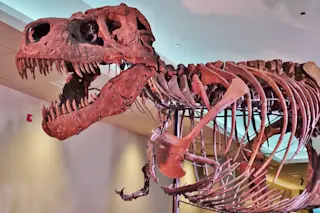A truck barrels down a dusty desert road in southern Utah’s vast Grand Staircase-Escalante National Monument, speeding through canyons and along cliffs toward a towering sandstone formation known as the Kaiparowits Plateau. Alan Titus, a Bureau of Land Management paleontologist here for nearly 20 years, is behind the wheel, his shaggy hair flapping in the July wind as Led Zeppelin blasts from the speakers.
Titus stops the truck on a shrubby hill. With his passenger, University of North Florida paleontologist Barry Albright, he sets off on a small foot path into the high desert.
The two men, longtime friends and collaborators, are heading to the scene of a catastrophe — and, possibly, the biggest find of Titus’ decades-long career.
Paleontologist Alan Titus surveys the vast landscape of southern Utah from the Kaiparowits Plateau, part of the Grand Staircase-Escalante National Monument. The area is rich in fossil remains from the Late ...















